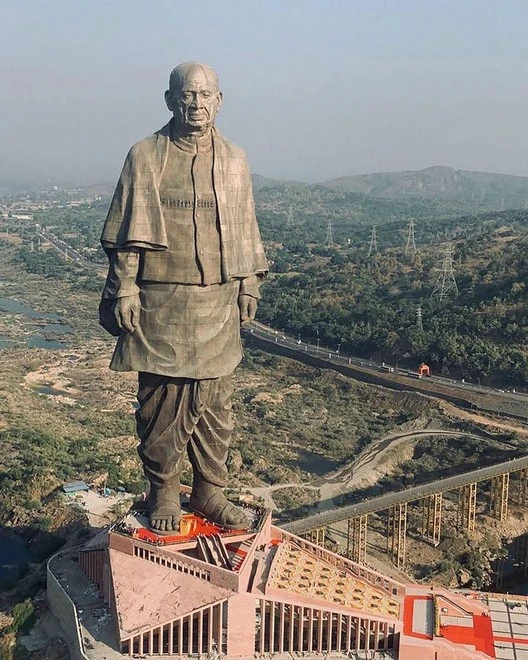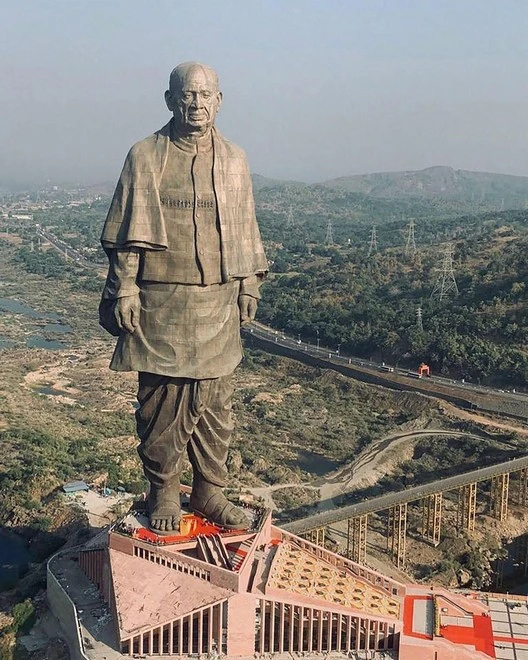Generated by Contentify AI

Introduction
Standing at a towering height of 182 meters, the Statue of Unity holds the title of the world’s tallest statue. Apart from its impressive height, it boasts several other fascinating features that make it a marvel of engineering and art. Crafted by renowned sculptor Ram V. Sutar, the statue is a tribute to Sardar Vallabhbhai Patel, a key figure in India’s struggle for independence. The statue’s location on the Sadhu Bet island on the Narmada River adds to its grandeur, attracting visitors from all over the world. The monument’s design incorporates intricate details that highlight various aspects of Patel’s life and legacy. Its construction involved the use of advanced technology and techniques to ensure its structural integrity and longevity. The viewing gallery inside the statue offers visitors a panoramic view of the surrounding landscape, providing a unique experience for tourists. The statue’s bronze cladding was sourced from various parts of India, symbolizing unity in diversity. The complex houses a museum that showcases Patel’s contributions and the history of Indian independence. The statue’s eco-friendly features, such as a sustainable water and power supply system, exemplify a commitment to environmental conservation. The lighting systems of the statue are meticulously designed to create striking visual effects, especially during the evening illumination. Overall, the Statue of Unity stands not only as a tribute to a great leader but also as a symbol of India’s unity, diversity, and technological advancement.
The Inspiration Behind the Statue
The inspiration behind the Statue of Unity stems from Sardar Vallabhbhai Patel‘s pivotal role in the unification of India after gaining independence in 1947. As the first Deputy Prime Minister and Home Minister of India, Patel worked tirelessly to integrate over 500 princely states into the newly formed nation. The statue symbolizes his vision of a united, strong India. The idea for the monument was proposed in 2010 by Prime Minister Narendra Modi, who envisioned it as a tribute to Patel’s contributions to the country. The statue not only honors Patel’s legacy but also serves as a reminder of the importance of unity and solidarity in a diverse nation like India. The location of the statue on the Sadhu Bet island was carefully chosen to provide a picturesque backdrop and to make it accessible to visitors from all over the country. The design of the statue incorporates elements that reflect Patel’s persona and his association with the Indian freedom struggle. The intricate detailing on the statue captures the essence of Patel’s leadership and his unwavering commitment to the nation. The Statue of Unity stands as a symbol of inspiration for present and future generations, reminding them of the values of unity, integrity, and selfless service to the nation.
Construction and Engineering Feats
The construction of the Statue of Unity required meticulous planning and innovative engineering feats. One remarkable fact is that the statue’s foundation goes as deep as 20 meters below ground level to ensure stability and prevent any tilting or sinking. The statue’s core is made of reinforced concrete, while the outer structure is covered with around 1,700 tons of bronze panels, giving it a striking appearance. The statue’s design incorporates intricate details that required the expertise of over 3,000 skilled workers and artisans. The statue also boasts a state-of-the-art bronze coating technology to protect it from corrosion and weathering. Additionally, the stainless steel structure inside the statue provides support against high winds and seismic activities. The statue’s construction involved the use of advanced 3D modeling and laser scanning techniques for precision and accuracy. It took approximately 42 months to complete the construction of this engineering marvel, which stands as a testament to human ingenuity and craftsmanship. The Statue of Unity’s engineering and construction processes exemplify a harmonious blend of artistry, technology, and structural integrity, making it a true masterpiece of modern engineering.
Symbolism and Cultural Significance
1. Standing tall at 182 meters, the Statue of Unity is not only the world’s tallest statue but also a symbol of India’s unity and diversity.
2. The statue’s location on Sadhu Bet island offers a stunning view of the Narmada River, adding to its grandeur and attracting visitors from around the globe.
3. Crafted by renowned sculptor Ram V. Sutar, the statue is a tribute to Sardar Vallabhbhai Patel, a key figure in India’s struggle for independence and unity.
4. The intricate design of the statue incorporates various elements that symbolize Patel’s leadership, vision, and contributions to the nation.
5. The construction of the statue involved the expertise of over 3,000 skilled workers and artisans who meticulously brought the monument to life.
6. The statue’s eco-friendly features, such as a sustainable water and power supply system, demonstrate a commitment to environmental conservation and sustainability.
7. The bronze cladding of the statue was sourced from different parts of India, symbolizing the country’s unity in diversity and cultural richness.
8. The statue’s viewing gallery offers visitors a unique experience, allowing them to admire a panoramic view of the surrounding landscape and appreciate the engineering marvel up close.
9. The lighting systems of the Statue of Unity are meticulously designed to create stunning visual effects, especially during the evening illumination, enhancing its beauty.
10. The museum housed within the statue complex showcases Patel’s life, contributions, and the history of Indian independence, providing visitors with a deeper understanding of its cultural significance and historical importance.
Visitor Experience and Tourism
Visitors to the Statue of Unity are treated to an unforgettable experience that combines art, history, and engineering marvels. The statue’s strategic location on Sadhu Bet island offers a picturesque setting, with the Narmada River flowing majestically around it, enhancing the visitor’s experience. The intricate design of the statue, crafted by renowned sculptor Ram V. Sutar, captures the essence of Sardar Vallabhbhai Patel‘s leadership and contributions to India’s independence movement. Visitors can explore the museum inside the complex, which provides insights into Patel’s life and the history of Indian independence, adding depth to their visit. The eco-friendly features of the statue, such as its sustainable water and power supply system, highlight a commitment to environmental conservation and sustainability. The bronze cladding sourced from different parts of India symbolizes the country’s rich cultural diversity and unity. The statue’s viewing gallery offers a unique opportunity for visitors to witness breathtaking panoramic views of the surrounding landscape, providing a different perspective of the monument. The lighting systems of the Statue of Unity are expertly designed to create mesmerizing visual effects, especially during the evening illumination, enhancing the overall visitor experience. These elements collectively make the Statue of Unity not just a statue but a symbol of unity, diversity, and technological advancement, offering visitors a truly enriching and unforgettable experience.
Comparisons to Other World Landmarks
1. The Statue of Unity commemorates Sardar Vallabhbhai Patel, known as the “Iron Man of India,” for his role in uniting over 500 princely states post-independence.
2. Standing at 182 meters, the statue surpasses iconic landmarks like the Statue of Liberty and Spring Temple Buddha in height, making it the tallest in the world.
3. Designed to withstand wind speeds up to 180 km/hour and earthquakes of magnitude 6.5 on the Richter scale, the statue showcases engineering excellence and structural stability.
4. The statue’s bronze cladding, weighing about 1,700 tons, was sourced from various regions of India, symbolizing the country’s unity in diversity.
5. The viewing gallery inside the statue can accommodate up to 200 visitors at a time, offering a panoramic view of the lush surroundings and the Narmada River.
6. The statue’s location on Sadhu Bet island was strategically chosen to provide a serene backdrop and ensure visibility from afar, attracting tourists from across the globe.
7. Visitors can explore the museum at the base of the statue, which showcases Patel’s life, contributions, and artifacts from India’s independence movement.
8. The intricate design details on the statue depict Patel’s attire, posture, and facial features, capturing the essence of his leadership and vision for a united India.
9. The lighting systems of the Statue of Unity are carefully crafted to create stunning visual effects during different times of the day, enhancing its beauty and grandeur.
10. The eco-friendly features, including a recycling and rainwater harvesting system, showcase a commitment to sustainability and environmental conservation at the site.
Conclusion
1. The Statue of Unity, standing at an impressive 182 meters, holds the title of the world’s tallest statue, surpassing renowned landmarks like the Statue of Liberty and Spring Temple Buddha.
2. The statue’s construction involved the expertise of over 3,000 skilled workers and artisans who meticulously brought the monument to life, showcasing a harmonious blend of artistry and engineering prowess.
3. The location of the statue on Sadhu Bet island offers visitors a picturesque view of the Narmada River, adding to its grandeur and attracting tourists from all corners of the globe.
4. Crafted by renowned sculptor Ram V. Sutar, the statue is a tribute to Sardar Vallabhbhai Patel, honoring his pivotal role in India’s independence movement and unity.
5. The statue’s engineering feats include a foundation that extends 20 meters deep, a stainless steel internal structure for support against high winds, and a state-of-the-art bronze coating technology for protection.
6. Visitors can explore the museum within the complex, which provides insights into Patel’s life, contributions, and the history of Indian independence, adding depth to their experience.
7. The eco-friendly features of the statue, such as a sustainable water and power supply system, demonstrate a commitment to environmental conservation and sustainability.
8. The intricate design details on the statue capture various elements of Patel’s persona, attire, and posture, reflecting his leadership and vision for a united India.
9. The viewing gallery inside the statue allows visitors to enjoy panoramic views of the surrounding landscape and the Narmada River, providing a unique and immersive experience.
10. The lighting systems of the Statue of Unity are meticulously designed to create stunning visual effects, especially during the evening illumination, enhancing its beauty and grandeur for visitors to admire.



